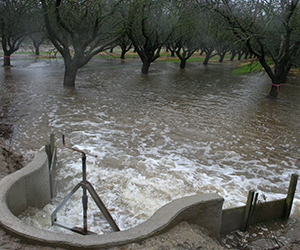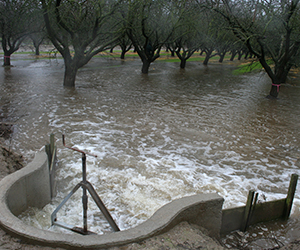
When the California state legislature passed the Sustainable Groundwater Management Act (SGMA) in 2014, they initiated a process to engage groundwater users in developing and implementing plans to manage their groundwater in a sustainable manner, over the long term. The Almond Board of California (ABC) is continuing to research best practices for grower participation in SGMA agencies and projects, including helping to determine if groundwater recharge is a fit with each individual’s operation.
“Under SGMA, there are really just two levers you can pull to achieve a groundwater balance — reduce the amount you take out of the ground, or put more water in,” said Jesse Roseman, senior specialist for Environmental and Regulatory Affairs at ABC. “If you lean on the former, you cause a fair amount of pain. Recharge is the more optimistic and visionary way of achieving sustainability.”
If growers aren’t already practicing recharge, they should explore this option ahead of next winter to determine if recharge will work on their operation. Getting an early start is important, as the recharge process may require paperwork that must be submitted to one’s local irrigation District or Groundwater Sustainability Agency (GSA), and proper nutrient management must be considered.
Location, Soil Considerations Key to Recharge
Growers have several options when considering how to do groundwater recharge. The simplest option involves using existing flood irrigation systems in the winter dormant season when there is excess available water that can percolate down and replenish the aquifer.
If a flood irrigation system isn’t available, the soil doesn’t drain well or other obstacles stand in the way, growers have other options, including:
- Installing a groundwater recharge pond on their property outside the orchard itself
- Fallowing an area within in the orchard that’s best for recharge to develop a pond (sandy areas are optimal)
- Working with a GSA to develop recharge projects elsewhere in their basin
When exploring recharge, growers, especially those with sandier soils, should be mindful of nutrient management to minimize nitrates leaching to groundwater. Current research is exploring how nitrates and salts move with applied water. ABC is also funding research aimed at developing remote sensing methods to identify which portions of a property are best suited for a recharge pond, based on soil type and permeability.
Another factor, reflected in ABC’s online mapping tool, is whether a grower’s orchard overlies deeper soil layers that are also permeable. To access this map, growers can visit Almonds.com/Maps, log in to the mapping system and check out the “Almond Groundwater Recharge Suitability” layer under the “Layer List.”
Recharge, either on-farm or in ponds, will help growers adapt to a future where groundwater pumping is dependent on sustainable management — but not all farms are a good fit. Once the decision is made to implement groundwater recharge, growers will still need to address potentially complex permitting issues, which ideally are addressed by local water districts through ongoing planning.
SGMA: Get Involved or Get Left Out
GSAs in critically over-drafted areas are required to develop Groundwater Sustainability Plans, or GSPs, by January 31, 2020. This means growers have less than nine months to join initial SGMA planning and groundwater recharge discussions among GSAs.
“We encourage growers and community members to participate in GSA meetings to determine how recharge can work in their basin and orchard,” Roseman said. “Through participation right now in the development of groundwater plans, growers have a unique opportunity to encourage adoption of recharge programs as part of the solution to bringing their basin into balance.”
To learn more about groundwater recharge, including the latest in almond-specific research, and to determine if this system is right for you and your GSA, check out “Where Might Almonds Fit into Groundwater Recharge?” If you’d like to learn more about SGMA, check out California’s Department of Water Resources’ SGMA Portal and ABC’s “Staying Up on SGMA” handout.
Growers also have a great opportunity to learn more about SGMA and other California water issues at “Navigating the Waters,” an event that will be hosted by the Almond Board of California on May 14, 2019 at the International Agri-Center in Tulare, California. See the agenda and RSVP information here.


